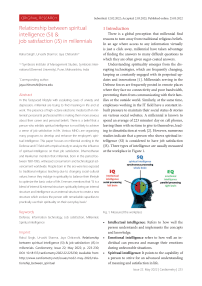Relationship between spiritual intelligence (SI) & job satisfaction (JS) in millennials
Автор: Singh R., Sharma U., Chitranshi J.
Журнал: Cardiometry @cardiometry
Рубрика: Original research
Статья в выпуске: 22, 2022 года.
Бесплатный доступ
In this fast-paced lifestyle with escalating cases of anxiety and depression, millennial are trying to find meaning in life and at work. The presence of high-octane electronic media both in millennial' personal & professional life is making them more anxious about their career and personal beliefs. There is a belief that a person who exhibits spiritual intelligence is most likely to achieve a sense of job satisfaction in life. Various MNCs are organizing many programs to develop and enhance the employee's spiritual intelligence. This paper focuses on millennial working in the Defense and IT field with empirical study to analyze the influence of spiritual intelligence on their job satisfaction. Dhamodharan and Ravikumar mention that millennial, born in the period between 1981-1995, witnessed consumerism and technological advancement worldwide. People born in this era were less exposed to traditional religious teaching due to changing social-cultural values; hence they indulge in spirituality to balance their lifestyle to optimize the basic value of life. Emmons mentions that “SI is a blend of internal & external structure: spirituality being an internal structure and intelligence as an external structure to create a new structure which evolves the person with remarkable capacities to practically use their spirituality on their everyday basis.”
Defense, information technology, job satisfaction, millennial, spiritual intelligence
Короткий адрес: https://sciup.org/148324599
IDR: 148324599 | DOI: 10.18137/cardiometry.2022.22.223230
Текст научной статьи Relationship between spiritual intelligence (SI) & job satisfaction (JS) in millennials
Rahul Singh, Urvashi Sharma, Jaya Chitranshi. Relationship between spiritual intelligence (SI) & job satisfaction (JS) in millennials. Cardiometry; Issue 22; May 2022; p. 223-230; DOI: 10.18137/cardiometry.2022.22.223230; Available from:
There is a global perception that millennial find reasons to turn away from traditional religious beliefs. In an age where access to any information virtually is just a click away, millennial have taken advantage of finding the answers to many difficult questions to which they are often given sugar-coated answers.

$Q spiritual intelligence synchronous processing whole brain
Intellectual intelligence serial processing left brain
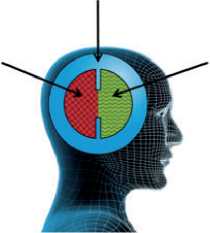
emotional Intelligence parallel processing right brain
Fig. 1. Measured the workplace

• Intellectual intelligence: Refers to how well the person understands and implements the concepts and knowledge.
• Emotional intelligence refers to how well an individual can process and manage their emotions during unfavorable situations.
• Spiritual intelligence: It points to the capability of a person to strive for an advanced understanding of meaning and satisfaction in life.
2.1 Millennials
Since spirituality is a little difficult to grasp, it is not because only words best explain spirituality, but because spirituality does not have a fixed definition per se. Every individual observes spirituality in their way. However, for spirituality, the best approach to understand is often felt or intuited ways of knowing. With some children and young people, maybe engaging themselves in recognizing and supporting God is their way of being spiritual [3]. For some people with high self-awareness and self-control to decide when and how to react in certain situations keeping their actions and behavior completely in control is their way of being spiritual. There have been studies, which concluded that spirituality is common and natural for children of all faiths and religions.
The term that Danah Zohar came up with is ‘SI in her book ‘Rewiring the corporate brain.’ Cindy Wigglesworth states that SI is “the capability of the person to decide when to act or react with compassion and wisdom, keeping ones outer and inner peace untroubled by the circumstances” [5].
2 Review of literature
According to Gunther and Business Week, spirituality at the workplace has been a topic of discussion in many business magazines, such as the cover story for both Fortunes, as stated by Conlin. According to Nimon, the millennial generation is a set of individuals who were born between the 1980s and 1990s [6]. Those people born from 1982 to 2012 are considered millennial, as observed by Howe and Strauss. As per Fog, the workplace values for millennial include recognition, hands-on advanced technology, regular feedback, personal, professional fulfillment, and fun.
The Millennial generation students and workforce are more ambitious and require structure for their achievement-oriented goals, as studied by Behrens. This generation comes from a society where parents hold a major role in deciding their children’s careers; they do not want their children to commit the same mistakes they did or their previous generation. Due to this, today’s millennials are held to high expectations and are expected to outperform above the norm [9]. This constant pressure by society and family has made this generation think beyond prayers and preaching’s about spirituality and spiritual intelligence. SI is defined by Zohar and Marshall as a competence that the people have in order to acknowledge and resolve their difficulties and place their actions to add meaning and value to their lives to live life meaningfully. In a study, Kimberly A. Greenway shows that women scored higher in terms of spirituality and purpose of life than men. The study indicates that millennials are now exploring the purpose and meaning of life [10].
2.2 Work spirituality
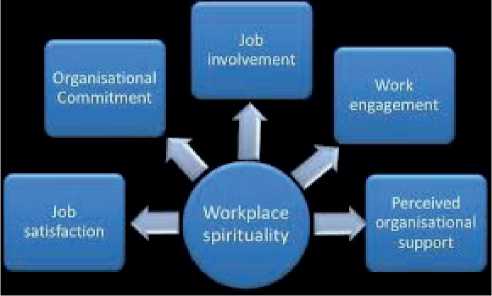
Fig. 2. Work spirituality
2.3 IT and defense profession
In one of the Medicine Military journals, MacDonald et al. discuss how spirituality affects veterans’ mental health and the importance of ‘positive spiritual coping’ in improving veterans’ well-being. Job Satisfaction (JS) is often said to be an optimistic spiritual state that results from the arrangement done in the work setting, as in an evaluator study by Arches 1991 [13].
3 Research gap
The linkage of spiritual intelligence with job satisfaction is in an embryonic stage in India. There has been some development in the application of spiritual intelligence in understanding employees’ effectiveness, but this has been restricted to western countries. India is yet to explore if the employee’s efficiency can be improved by spiritual intelligence [14]. There is a dearth of research on this subject in India due to its differences in socio-economic class, culture, infrastructure, and population. Based on the fact that 75% of the global workforce is millennial and factual research is conducted to understand the SI on job satisfaction in millennial, this generation was selected.
Sector: Though there have been studies conducted in India on understanding the SI and JS in banking, hospitality, and teaching professions, there has been no research done in Defense and IT [15].
4 Research objectives
1. To study the relationship between SI and JS in millennial.
2. To analyze the difference between SI and JS between men and women.
6.1 Method of data collection
6.2 Sampling
5 Hypotheses
Based on the reviewed literature mentioned in the review of literature segment, following the hypothesis is formulated:
H 1 : There is a noteworthy and positive relationship between SI and JS in millennial working in the Defense and IT field.
6 Research methodologies
The data has been collected and analyzed in the following method.
Questionnaire: For this study to measure spiritual intelligence, a reliable standardized King’s SISRI questionnaire contained 24 sets of questions. Similarly, to measure job satisfaction, a Stamp and Piedmont’s JSS questionnaire was used. A detailed description of the questionnaire has been provided in the pages ahead [16].
Figure 3, it is observed that out of 118 respondents, 79.7% were men, and 20.3% were women who work in the Defense field and Multinational Information Technology Companies. Owing to the title, all the respondents were millennial born between 1980 and 1997.
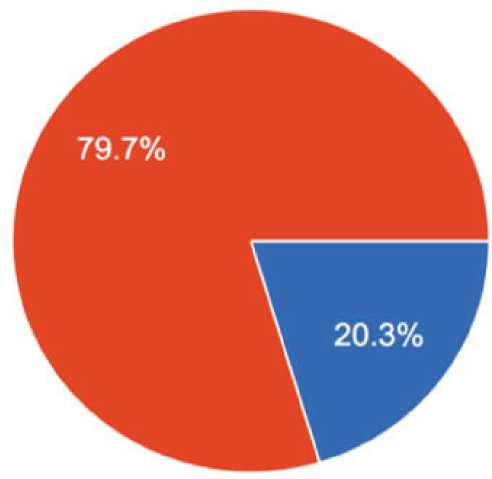
Fig. 3. Gender respondents
A figure 4 show depicts the occupation of the respondents. It is observed that the millennial were majorly from Defense and IT fields. Of 118 respondents, 66.9% of millennial were from defense, and 33.1% were from IT.
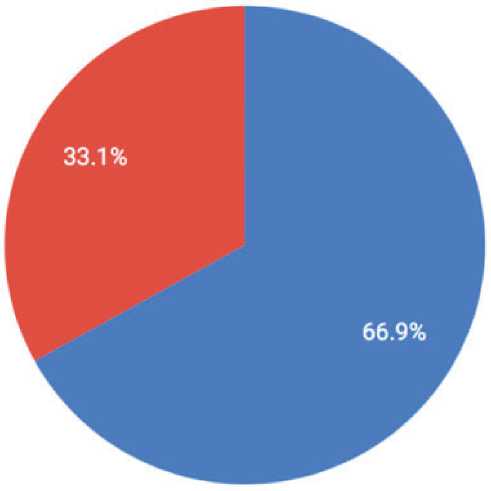
Fig. 4. Occupation in respondents
6.3 Questionnaire
A questionnaire containing 36 questions of SI and JSS was floated to collect data for the research pur- 226 | Cardiometry | Issue 22. May 2022
pose. Likert Scale rating is used where the responses varied from 5 being completely agreed and 1 completely disagreeing. Since the hypothesis and findings will be backed by statistical analysis, a well-structured questionnaire is used. A reliable standardized King’s SISRI questionnaire was used to measure spiritual intelligence, which contained 24 sets of questions. Similarly, to measure job satisfaction, a Stamp and Piedmont’s JSS questionnaire was used [18].
6.4 SISRI-24
For measuring spiritual intelligence: the SISRI-24 scale is used.
6.5 JSS
7 Results and discussion 7.1 Data analysis tool
The collected data was analyzed using Statistical Package Social Sciences Program (SPSS) and Google sheets. The survey is analyzed using the Reliability test, coefficient correlation.
The reliability test is commonly done to measure the internal consistency of the questionnaire. An ideal Cronbach’s alpha score in this test should be above 0.70. The Cronbach’s alpha score above 0.80, where the questionnaire is considered reliable to work with, is considered good and highly reliable.
Table 1 shows the Reliability test conducted on 57 items of JS and SI yielded a Cronbach’s alpha score of 0.723 and 0.886, respectively, which is more than the recommended score of 0.7 and is acceptable for the further analysis of the data, as per George and Mallery.
SI and JS were measured in men and women. The t-value came out to be 0.712 and 0.932, respectively, which is insignificant, indicating that gender plays no role in SI and JS. Therefore, there is no difference in SI and JS in men and women.
Table 1. Reliability test on SISRI and JSS
|
Variables |
Respondents |
Cronbach’s alpha score |
|
Spiritual Intelligence |
118 |
0.886 |
|
Job Satisfaction |
118 |
0.723 |
|
Overall |
118 |
0.883 |
Figure 5 shows respondents were asked to rate the job satisfaction survey if they like their work; 50% of the millennial agreed with the statement, implying that the nature of work plays a vital role in the workspace. In the figure above, it can be observed that 50% of the respondents feel a sense of achievement and pride from the kind of work they do.
According to Table 2 , the mean of Critical Existential Thinking, Personal Meaning Production, Transcendental Awareness, Conscious State Expansion, and Job Satisfaction was 4.23, 4.09, 3.93, 3.85, and 3.22 respectively.
In Table 3 , the result of ANOVA was significant, F (24.3, 117), p < 0.001 indicates a significant relationship between JS and SI & hence the hypothesis is proved.
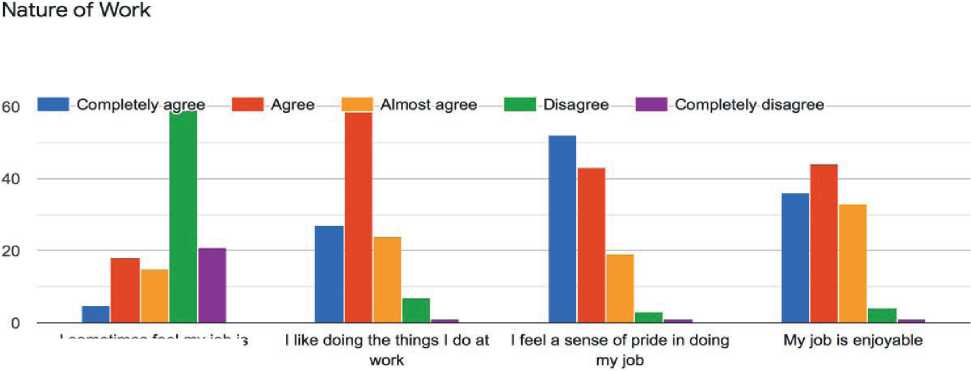
Fig. 5. Job satisfaction
I sometimes feel my job is meaningless
Table 2
Descriptive statistics of SI and JS
|
Statistical Index |
Mean |
Standard Deviation |
|
Spiritual Intelligence |
||
|
Critical Existential Thinking |
4.23 |
0.88 |
|
Personal Meaning Production |
4.09 |
0.94 |
|
Transcendental Awareness |
3.93 |
0.92 |
|
Conscious State Expansion |
3.85 |
0.99 |
|
Job satisfaction |
||
|
Pay |
3.3284 |
0.56111 |
|
Promotion |
3.3178 |
0.67831 |
|
Supervision |
2.9703 |
0.42639 |
|
Fringe Benefit |
3.1801 |
0.58369 |
|
Operating condition |
3.2373 |
0.74954 |
|
Coworker |
3.2966 |
0.55657 |
|
Nature of work |
3.5996 |
0.54610 |
|
Communication |
2.8919 |
0.73269 |
Table 3
Correlation coefficient between SI and JS in millennial
Table 4 shows the relation between SI & variables of JS in millennial. The analysis proves that the relationship between SI and various components of JS in millennial is significant. The data indicates strength of relation between SI and the nature of work (r=0.413), pay (r=0.323), promotion (r=0.371), supervision (0.314), fringe benefit (r=0.246) and coworkers (r=0.200). Therefore, the hypothesis has been proved significant and positive.
Table 4
Coefficient Correlation between SI and various variables of JS
|
Dependent variable |
Spiritual Intelligence |
|
|
Statistical Index |
||
|
Predictor variables |
Correlation coefficient |
Squared Correlation coefficient |
|
Pay |
0.323** |
0.104 |
|
Promotion |
0.371** |
0.137 |
|
Supervision |
0.314** |
0.098 |
|
Fringe benefit |
0.246** |
0.060 |
|
Operating conditions |
0.175 |
0.030 |
|
Coworkers |
0.200* |
0.04 |
|
Nature of work |
0.413** |
0.170 |
|
Communication |
0.123 |
0.015 |
** Correlation is significant at the 0.01 level (2-tailed)
*Correlation is significant at the 0.05 level (2-tailed).
Table 7 indicates that the more the person expands their SI, the more they tend to achieve the sense of JS. The equation below shows that with one unit of increase in the beta coefficient of SI & JS increases by 0.313 units.
Table 5
|
Pearson’s r |
Spiritual intelligence |
Job satisfaction |
|
|
Spiritual |
Pearson correlation |
1 |
0.417** |
|
intelligence |
Sig. (2-tailed) |
0.000 |
|
|
N |
118 |
118 |
|
|
Job |
Pearson correlation |
0.417** |
1 |
|
satisfaction |
Sig. (2-tailed) |
0.000 |
|
|
N |
118 |
118 |
** Correlation is significant at the 0.01 level (2-tailed)
Table 6
|
Spearman’s rho |
SI |
JS |
|
|
SI |
Correlation coefficient Sig. (2-tailed) N |
1.000 118 |
0.407** 0.000 118 |
|
JS |
Pearson correlation Sig. (2-tailed) N |
0.407** 0.000 118 |
1 118 |
** Correlation is significant at the 0.01 level (2-tailed)
Table 7
Beta Coefficient of SI components to predict JS
|
Un standardized Coefficients |
Standard-ized Coefficient |
||||||
|
Depen- |
Pre- |
B |
Std. |
Beta |
t |
Sig. |
|
|
dent |
dictor |
Error |
|||||
|
Variable |
Variable |
||||||
|
(Con- |
1.968 |
0.257 |
7.650 |
0.000 |
|||
|
stant) |
|||||||
|
Job |
Spiritual |
0.313 |
0.063 |
0.417 |
4.935 |
0.000 |
|
|
Satis- |
Intelli- |
||||||
|
faction |
gence |
||||||
Job satisfaction = Spiritual intelligence (0.313) + + Constant coefficient (1.968)
8 Conclusions
These days, human resource management is formulating strategies for increasing and developing SI. The findings above suggest that human resource managers and command authority of IT and defense forces, respectively, should have some policies to monitor and equip employees to enhance their spiritual intelligence. It has been mentioned in Sisk (2018) that high spiritual intelligence leads to high productivity, which might hold in the case of millennial in the Defense and IT professions. Therefore, there is a long way to explore SI and JS in millennial working in various other sectors to establish firm policies to develop spiritual intelligence at the workplace. With people becoming more aware of spirituality at the workplace, the future may see various creative and interactive heuristic approaches to develop and expand one’s SI at work. A detailed description of the questionnaire has been provided in the pages ahead.
9 Implications for Practice
In this study, the SI and JS of millennial employees in defense forces and IT MNCs were measured and analyzed to draw statistical conclusions about the consequences of spiritual intelligence on job satisfaction.
It is important to understand that spiritual intelligence in millennial makes them feel content at work so that the HR policies could be amended accordingly. Spiritual intelligence brings more job satisfaction and hence improved performance, leading to the achievement of the organizational goal.
10 Recommendations
This study has opened a new avenue for researchers to consider millennial from different professions like defense and IT MNCs for the underlying factors of job satisfaction. It is justified to state that spiritual intelligence leads to job satisfaction in most professions. For example, millennial from Defense Forces take up humongous challenges, which are life-threatening at times? However, their dedication and commitment to their work show that their sense of job satisfaction has emerged from spiritual intelligence and vice versa.
-
• There should be an annual survey to measure the SI of the employees to understand if spiritual intelligence in millennial makes them feel content at work.
-
• There can be support groups to help employees explore, embrace, and hone their spiritual intelligence. This support group can also advise the employees on how to handle daily conflicts.
-
• Proper communication channels should be established since the nature of work that the employee does. The supervision they get is seen to play a major role in achieving job satisfaction.
Список литературы Relationship between spiritual intelligence (SI) & job satisfaction (JS) in millennials
- D. P. Ashmos, D. Duchon, Spirituality at work: a conceptualization and measure. Journal of Management Inquiry, 9(2), 134-45, (2000).
- W. Behrens, Managing millennials. Marketing Health Services, 29(1), 19-21, (2009).
- M. Conlin, Religion in the workplace: the growing presence of spirituality in corporate America, Business Week, November 1, 150, (1999).
- M. Gunther, God and business. Fortune, July 9, 58-80, (2001).
- N. Howe, W. Strauss, Millennials rising: The Next Great Generation. New York, NY: Vintage (2000).
- R. Indradevi, Workplace spirituality: successful mantra for the modern organization, Journal of Critical Reviews, 7 (6), (2020).
- I. I. Mitroff, E. Denton, A study of spirituality in the workplace magazine: summer 1999, Research Feature, July 15, 1999.
- J. W. Moon, Y. G. Kim, Extending the TAM for a world with web context. Information and management, 38, 217– 231, (2001).
- C. J. Mottaz, Work satisfaction among hospital nurses, Hospital and Health Services Administration, 33(1), 57-74, (1988).
- S, Nimon, Generation Y and higher education: The other Y2K. Journal of Institutional Research, 13(1), 24–41, (2007).
- C. L. Park, Religion as a meaning-making framework for coping with life stress. Journal of Social Issues, 61(4), 707-729, (2005).
- P. Scanlon, D. R. Neumann, Internet plagiarism among college students. Journal of College Student Development, 43(3), 374–385, (2002).
- M. J. Schmit, S. P. Allscheid, Employee attitudes and customer satisfaction: making theoretical and empirical connections. Personnel Psychology, 48, 521-532, (1995).
- D. Sisk. Engaging the spiritual intelligence of gifted students to build global awareness in the classroom.Roeper Review, 30(1), 24-30, (2008).
- P. L. Stamps, E. B. Piedmont, Nurses and work satisfaction: An index for measurement. Ann Arbor, MI: Health Administration Press Perspectives (1986).
- P. Taylor, S. Keeter, (Eds.). Millennials: A portrait of generation next. Retrieved from the Pew Research Center (2010).
- R. N. Wolman, Thinking with your soul: spiritual intelligence and why it matters, New York: Harmony Books (2001).
- D. Zohar, I. Marshall, SQ: Connecting with our Spiritual Intelligence. New York: Bloomsbury, (2000).

